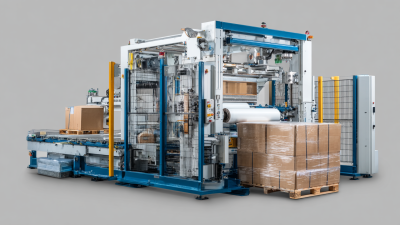How to Choose the Best Shipping Supplies for Your Business Needs
When running a successful business, the importance of selecting the right shipping supplies cannot be overstated. In today's fast-paced e-commerce environment, the efficiency and reliability of your shipping process can significantly impact customer satisfaction and, ultimately, your bottom line. The variety of shipping supplies available can be overwhelming, ranging from boxes and envelopes to packing materials and labeling options. Each type of supply plays a crucial role in ensuring that your products reach customers safely and in good condition. Therefore, understanding how to choose the best shipping supplies tailored to your specific business needs is essential to streamline operations and enhance your brand's reputation. In this blog, we will explore key considerations to help you make informed decisions on shipping supplies that not only meet your needs but also improve your overall shipping strategy.

Identifying Your Business's Unique Shipping Volume: Key Factors to Consider
When choosing the best shipping supplies for your business, it's essential to identify your unique shipping volume and other key factors. Understanding your average shipment size, frequency, and the nature of the goods being shipped can significantly influence your packaging and shipping supply choices. For instance, companies with a large volume of small orders may benefit from using lightweight, cost-effective materials that reduce overall shipping costs, a concept aligned with the benefits of economies of scale.
Tips: Analyze your shipping data regularly to better understand your patterns. This can help you optimize your inventory management through stock-keeping units (SKUs), which track your products effectively and enable you to adjust your shipping supplies accordingly. By incorporating activity-based costing (ABC), you can attribute shipping expenses directly to specific products, ensuring you make informed decisions that correlate with your business's operational needs.
Additionally, consider the variable costs associated with different shipping materials and methods. Utilizing robust packaging solutions may seem costly upfront, but they can lower variable costs by minimizing product damage and returns. Monitoring your shipment metrics and adjusting your strategies based on accurate data will lead to more efficient operations and ultimately enhance your service delivery to your customers.
Shipping Supplies Volume Analysis
Understanding Various Shipping Materials: Durability and Cost-Effectiveness
When selecting shipping supplies for your business, understanding the durability and cost-effectiveness of various materials is vital. As the shipping sector evolves, businesses are presented with a plethora of options ranging from eco-friendly packaging to traditional materials like cardboard and plastic. Each material possesses distinct advantages and disadvantages that are influenced by factors such as product weight, size, and fragility. For instance, robust materials like foam inserts and corrugated boxes offer superior protection for fragile items, yet they may come at a higher price point.
Conversely, cost-effective materials like paper and lightweight plastics can help keep shipping expenses down while still providing adequate protection for less delicate products. The trend toward sustainability in packaging has also gained traction, with businesses increasingly opting for recyclable and biodegradable materials, which not only preserve product integrity but also align with environmental goals. By carefully weighing the durability against the cost-effectiveness of shipping supplies, companies can ensure they meet both their logistical needs and sustainability targets, ultimately benefiting their bottom line.
How to Choose the Best Shipping Supplies for Your Business Needs - Understanding Various Shipping Materials: Durability and Cost-Effectiveness
| Shipping Material | Durability | Cost-Effectiveness | Best Use |
|---|---|---|---|
| Cardboard Boxes | Moderate | High | General shipping, lightweight items |
| Bubble Mailers | High | Moderate | Fragile or small items, personal items |
| Plastic Bags | Low | Very High | Non-fragile items, apparel |
| Stretch Film | Very High | Moderate | Palletized items, bulk shipping |
| Foam Inserts | High | Low | Highly fragile items, electronics |
Evaluating Shipping Supplies Based on Delivery Speed and Customer Expectations
When selecting shipping supplies, it's crucial to consider delivery speed and customer expectations, which are increasingly shaping the logistics landscape. According to a 2023 survey by Logistics Management, 70% of consumers are prepared to pay more for faster shipping options, highlighting a growing demand for efficiency in delivery services. Businesses that prioritize speed in their shipping process can gain a competitive edge by meeting or exceeding customer expectations.
In the realm of shipping supplies, the choice of materials greatly influences delivery times. For example, using lightweight yet durable packaging can reduce shipping costs and improve delivery speed. A report from Supply Chain Dive indicates that companies employing appropriate packaging solutions experience a 30% reduction in shipping delays. Therefore, businesses should carefully evaluate their shipping supplies to optimize both the speed of delivery and the quality of customer service, ensuring that they align with modern consumer demands for promptness and reliability.
Calculating the Impact of Packaging on Shipping Costs and Environmental Sustainability
 When selecting shipping supplies, businesses must consider the significant impact of packaging on both shipping costs and environmental sustainability. According to a report by the Sustainable Packaging Coalition, about 30% of the total costs in the shipping industry is influenced by the choice of packaging materials. This statistic highlights the importance of selecting packaging that not only protects products but also optimizes weight and dimensions to reduce shipping expenses. For instance, utilizing lightweight materials like corrugated cardboard can lower transportation costs by minimizing freight charges.
When selecting shipping supplies, businesses must consider the significant impact of packaging on both shipping costs and environmental sustainability. According to a report by the Sustainable Packaging Coalition, about 30% of the total costs in the shipping industry is influenced by the choice of packaging materials. This statistic highlights the importance of selecting packaging that not only protects products but also optimizes weight and dimensions to reduce shipping expenses. For instance, utilizing lightweight materials like corrugated cardboard can lower transportation costs by minimizing freight charges.
Additionally, the environmental implications of packaging choices cannot be overlooked. A study from the Ellen MacArthur Foundation reveals that the global plastic packaging waste is projected to reach 2.3 billion tons by 2040 if current trends continue. By opting for recyclable or biodegradable materials, businesses can significantly reduce their carbon footprint and promote sustainability. Moreover, companies that adopt eco-friendly packaging solutions may also attract environmentally conscious consumers, potentially increasing market share. Thus, weighing the cost and environmental impact of shipping supplies is essential for a business's long-term success and responsibility.
Exploring Innovations in Shipping Supplies: Eco-Friendly and Cost-Saving Solutions
The shift towards sustainability in shipping supplies is becoming increasingly crucial as businesses aim to minimize their environmental footprint while maintaining cost-efficiency. Recent innovations in eco-friendly packaging materials, as highlighted in various industry reports, offer exciting opportunities for companies to adopt greener practices. For instance, the reusable packaging market is projected to reshape the industry significantly, with a worth estimated at $174.5 billion by 2030, driven by innovations that focus on lightweight, recyclable, and biodegradable materials.
In the cosmetics industry, sustainable packaging practices are gaining momentum, employing refillable systems and materials designed to reduce waste. With the global pharmaceutical packaging market expected to reach $6.12 billion by 2034, businesses are encouraged to explore sustainable options that not only align with regulatory standards but also appeal to eco-conscious consumers. This growing trend emphasizes the necessity for businesses to rethink their supply chains and implement sustainable practices that promote longevity and efficiency. By embracing these innovations, companies can effectively reduce their environmental impact while taking advantage of cost-saving solutions in their shipping operations.

Related Posts
-

7 Best Practices to Optimize Your Usage of Corrugated Cardboard for Packing Solutions
-

Innovative Examples of How Packaging Machines Transform Production Efficiency
-

7 Innovative Tips for Selecting the Best Packaging Supplies for Your Business
-

The Essential Guide to Choosing the Right Honeycomb Packing Paper for Your Business
-

7 Essential Tips for Choosing the Best Bulk Shipping Supplies Worldwide
-

Unlocking Efficiency and Savings with Pallet Wrap Machines Advantages for Your Business
